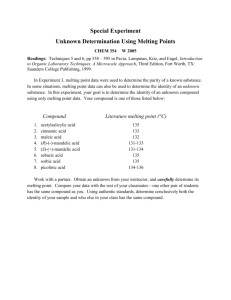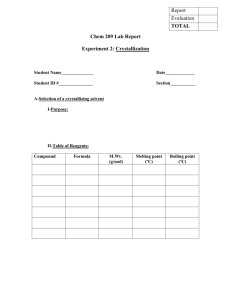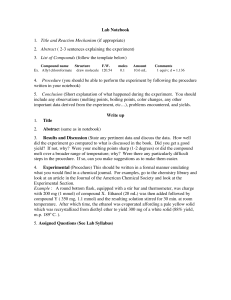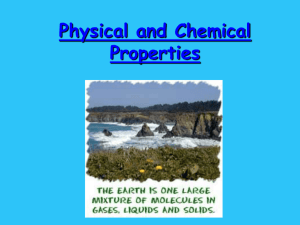Version C. A) irritation to eyes and excess tearing
advertisement
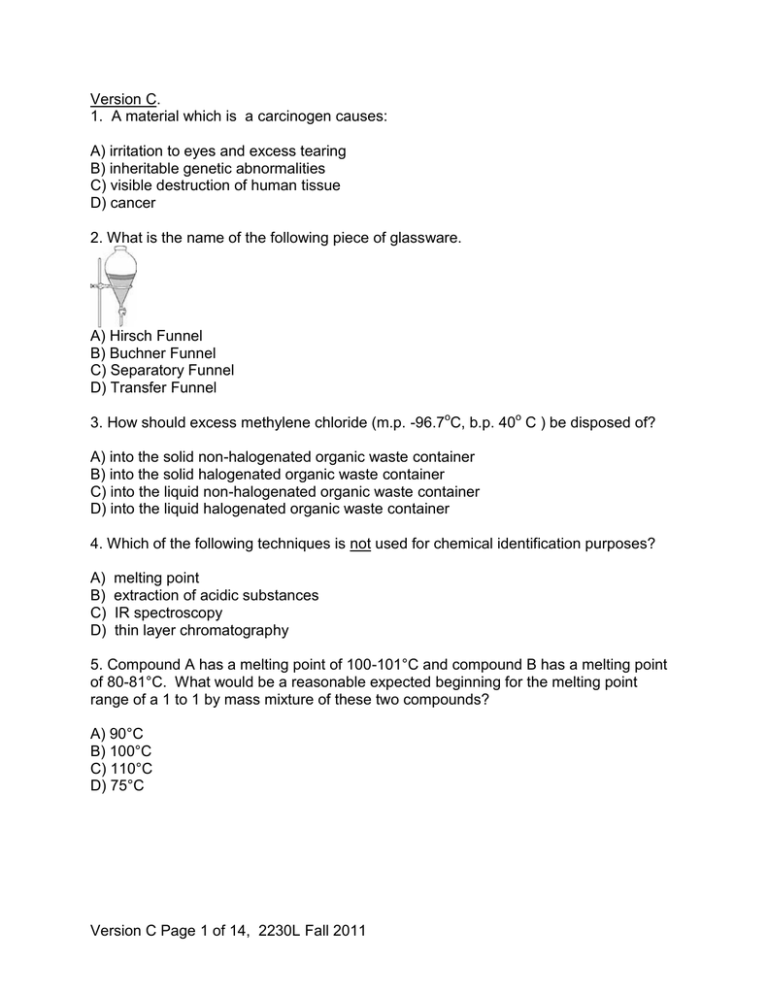
Version C. 1. A material which is a carcinogen causes: A) irritation to eyes and excess tearing B) inheritable genetic abnormalities C) visible destruction of human tissue D) cancer 2. What is the name of the following piece of glassware. A) Hirsch Funnel B) Buchner Funnel C) Separatory Funnel D) Transfer Funnel 3. How should excess methylene chloride (m.p. -96.7oC, b.p. 40o C ) be disposed of? A) into the solid non-halogenated organic waste container B) into the solid halogenated organic waste container C) into the liquid non-halogenated organic waste container D) into the liquid halogenated organic waste container 4. Which of the following techniques is not used for chemical identification purposes? A) B) C) D) melting point extraction of acidic substances IR spectroscopy thin layer chromatography 5. Compound A has a melting point of 100-101°C and compound B has a melting point of 80-81°C. What would be a reasonable expected beginning for the melting point range of a 1 to 1 by mass mixture of these two compounds? A) 90°C B) 100°C C) 110°C D) 75°C Version C Page 1 of 14, 2230L Fall 2011 6. Given the enlarged section of a thermometer, what is the correct temperature to record in oC? A) 93 B) 93.0 C) 93.00 D) 93.000 7. The melting point of a sample contaminated with a small amount of an insoluble impurity, such as sand, would be expected to be ... A) the same as pure sand B) the same as the pure sample C) higher than the pure sample D) lower than the pure sample 8. A chemist found that the melting point range of Unknown X was 182-185°C. The literature suggested that X must be one of four compounds. Those were: Compound A, literature melting point range 184-185°C Compound B, literature melting point range 184-187°C Compound C, literature melting point range 182-183°C Compound D, literature melting point range 181-184°C The chemist made mixtures of X with each of the four compounds. The melting point ranges of these mixtures were: X with A, 184-185°C; X with B, 178-185°C; X with C, 170-181°C; X with D, 176-184°C. What is Unknown X? A) B) C) D) Compound A Compound B Compound C Compound D 9. What would be the end result of recrystallization in which NOT ENOUGH recrystallization solvent was used? A) No effect B) The obtained product would have low levels of impurities. C) A lower than expected recovery would result D) The obtained product would have high levels of impurities Version C Page 2 of 14, 2230L Fall 2011 10. If you were going to carry out a recrystallization of benzoic acid and the following solvents were available, which would be your best choice of solvent to use for this recrystallization? This table lists the solubility of benzoic acid per 100 grams of solvent at 20oC and 80oC and the boiling point of the solvent. Solvent grams Benzoic grams Benzoic Acid/100 Boiling Point of Acid/100 g g solvent at 80o C Solvent, oC solvent at 20 o C A 0.50 98.2 302 B 0.50 95.3 127 C 28.4 95.3 95 D 0.50 15.8 115 A) Solvent A B) Solvent B C) Solvent C D) Solvent D 11. A student has 1.00 g. of a crude product that exhibits a melting point of 121.5122.0°C. After recrystalization 0.50 g of purified product are recovered with a melting point of 121.5-121.9°C. Which is the best interpretation of these results? A) The original product was pure, and some of it remained in the solvent when crystallizing. B) The original product was impure, and the impurity weighed 0.5g. C) More solvent needs to be removed from the purified product. D) The original material was impure and the recovered material still contains impurities. 12. If you are purifying a 1.00 g sample which is contaminated by 20 wt % of an impurity, what is the maximum amount in grams of a pure sample you could recover? A). 1.20 g B) 0.20 g C) 0.80 g D) 1.00 g 13. What is the reading from the refractometer shown? A) 1.33046 B) 1.336 C) 1.346 Version C Page 3 of 14, 2230L Fall 2011 D) 1.3346 14. The refractive index of water is taken. The display is on the left. On the same instrument, an unknown sample Z is measured. From the display shown, what is the corrected refractive index of Unknown Z? The literature value of the refractive index of water is 1.3330. A) 1.4262 B) 1.4255 C) 1.4276 D) 1.4269 15. A mixture of Ethylacetate (EA) and Butyl acetate (BA) was analyzed on a refractometer. A corrected refractive index of 1.3804 was obtained. The refractive index of pure ethyl acetate is 1.3723 and of pure butyl acetate is 1.3941. What is the composition of the mixture? A) 59.9 % EA & 40.1 % BA C) 62.8 % EA & 37.2 % BA B) 40.1 % EA & 59.9 % BA D) 37.2 % EA & 62.8 % BA 16. The following reaction was performed: 2-methyl-2-hexanol + HCl → 2-chloro-2-methylhexane + H2O 4.25 mL of 2-methyl-2-hexanol (density 0.812 g/mL, Mol. Wt. 116 g/mol) was mixed with 14.8 mL of 12M hydrochloric acid to form 2-chloro-2-methylhexane (Mol. Wt. 134.5 g/mol). If 3.58 grams of 2-chloro-2-methylhexane were isolated, then what was the percent yield? A. B. C. D. 3.58 % 81.8 % 89.5 % 84.2 % 17. You measure out material on the balance. The balance display reads 1.2000 g. Which of the following describes what you should do with this number. A) Record 1.2000 g in your notebook. Later neatly write this on datasheet. B) Record 1.2 g in your notebook. Later neatly write this on datasheet. C) Record 1.2000 g on your datasheet. Later neatly write this in your notebook. D) Record 1.2 g on your datasheet. Later neatly write this in your notebook. Version C Page 4 of 14, 2230L Fall 2011 18. Which of these compounds gives the spectrum shown? A) Cyclohexane B) Cyclohexanol C) Cyclohexanone D) Cyclohexanecarboxylic acid 19. If you were trying to distinguish between an ester and a ketone what region in the IR would you examine? A) Region I, 3100-3600 cm-1 B) Region III, 2100-2400 cm-1 C) Region IV, 1680-1800 cm-1 D) Region V, 1050-1200 cm-1 20. Which of these statements describes the relationship between frequencies in the IR. A) 3100 cm-1 is higher energy than 1100cm-1 B) 3100 cm-1 is lower energy than 1100cm-1 C) 3100 cm-1 is higher amplitude than 1100cm-1 D) 3100 cm-1 is lower amplitude than 1100cm-1 21. Which of the following pairs cannot be easily distinguished by IR spectroscopy? A) heptane and heptanol B) heptanoic acid and heptanone C) heptane and octane D) heptane and heptanoic acid Version C Page 5 of 14, 2230L Fall 2011 22. Below is a GC trace which was made on a system with the following conditions. Flow = 60mL/min Inj.=Det= 120oC Column = 80oC= Carbowax 5 %, 4” x 1/8” Chart Speed = 2.0 cm/min Injection volume = 2 l What is the retention time of peak B? A. 2.5 minutes B. 5.5 minutes C. 22.0 minutes 23. What is the area of the peak below? A. 3.7 cm2 B. 108 cm2 C. 22.7 cm2 D. 7.4 cm2 Version C Page 6 of 14, 2230L Fall 2011 D. 10.0 minutes 24. A mixture of following compounds was injected to a gas chromatograph (Carbowax 5 %, 4” x 1/8”Column) Compound Boiling Point °C Mol. Wt. g/mol Refractive Index (nD) Methylcyclohexane 101 112 1.422 Pentane 36 72 1.358 Octane 126 114 1.398 2,3-dimethyloctane 165 142 1.367 heptane 98 100 1.387 Which compound has the longest retention time? A. pentane B. methylcyclohexane C. 2,3-dimethyloctane D. octane 25. If the temperature of the column is raised by 15oC, what will happen to the retention time of the compounds? A. retention time will increase B. retention time will decrease C. retention time will not change D. the change in retention time can not be predicted. 26. Given the chart of number of drops verses temperature below, what is the boiling point of the second compound to distill? 125 120 Temperature (C) 115 110 105 100 95 90 85 80 75 0 5 10 15 20 25 30 Drops A) 87o C B) 105o C C) 115o C D) 116o C 27. The process whereby liquids continuously boil in a lower portion of a distillation apparatus, the vapors rise then condense and drop back down, is called what? A) a theoretical plate B) a eutectic mixture C) an azeotrope D) reflux Version C Page 7 of 14, 2230L Fall 2011 28. How many tetrahedral stereocenters are in the compound shown? A) 6 B) 4 C) 3 D) 2 29. A solution was made by mixing 0.673 g of an unknown material in 25.00 ml of water and test the rotation in a 20.0 cm tube. This material rotates light by + 7.87o. What is the specific rotation of this material?( []= / (c * l ) . A) + 146 o B) + 14.6 o C) + 1.46 o D) + 0.146 o 30. A mixture of (R)-2-butanol and (S)-2 butanol has an optical rotation of +4.87o. The specific rotation of pure (R)-2- Butanol is +13.50. What are the percentages of the (R) and (S) isomers in this sample? A) 36.1% (R), B) 63.9% (R), C) 68.0% (R) , D) 32.0% (R), 63.9% (S) 36.1% (S) 32.0% (S) 68.0% (S) 31. You take 0.498 g of a sugar and dissolve it in 25.00 ml of water and take a polarimetry reading using the 2.0 dm tube. Your observed rotation is + 3.25o. Given these literature values for specific rotations, what is your compound? Name ] D-Glucose +98 D- Galactose + 82 D-Allose +15 Sucrose +64.5 Maltose +178 A. D-Allose B. D-Galactose C. Sucrose D. Maltose Version C Page 8 of 14, 2230L Fall 2011 32. Calculate the Rf of the spot on the TLC plate shown. A) 0.30 B) 0.38 C) 0.50 D) 3.0 33. Given the following TLC plate, list compounds A, B & C in order of decreasing polarity: (The highest polarity in each is in bold) A). B > A > C C). A > C > B B). C > A > B D). B > C > A 34. In this TLC plate an authentic sample of caffeine is on the left and reaction product S is on the right. Which of the following conclusions is best supported by this TLC plate? s olvent front origin A) B) C) D) S is pure caffeine S is impure caffeine S is a pure compound but not caffeine S is an impure compound that is not caffeine Version C Page 9 of 14, 2230L Fall 2011 35. Which compound from the TLC/Column experiment had the largest Rf value and why? A) Ferrocene because it was more polar. B) Ferrocene because it was less polar C) Acetylferrocene because it was more polar D) Acetylferrocene because it was less polar 36. A TLC plate has been run and the following Rf values have been found for compounds A, B, C, and D. Compound Rf A 0.45 B 0.29 C 0.065 D 0.81 Predict the order (first to last) of elution from an alumina column. (to elute means to exit or dissociate) A) C, B, A, D B) B, C, D, A C) A, D, C, B D) D, A, B, C 37. What is the main use of column chromatography? A) to depolarize liquid mixtures B) to identify unknown compounds in a mixture C) to determine the polarity of compounds D) to purify solids 38. In the separation of acidic substances experiment, what was expected to be present in the organic layer after extractions with NaHCO3? A) 2-naphthol only B) benzoic acid only C) both of the above D) neither of the above Version C Page 10 of 14, 2230L Fall 2011 39. 2-naphthol (pKa 9.1) and cyclopentadiene (pKa 16) are dissolved in MTBE. The following four bases are available. Which one would be best to get the 2-naphthol to enter the aqueous phase as napthanoate anion and leave the cyclopentadiene in the organic layer? The bases are listed with the pKa values of their conjugate acids. (Hint: The lower the pKa, the stronger the acid. The stronger the acid the weaker the conjugate base.) A) HC≡CNa B) NH2-C6H4-ONa C) NO2-C6H4-ONa D) NaF 25 10.3 7.2 3.1 40. What is the structure of benzoic acid? 41. During the acidic separation a student began with 40.0 mL of MTBE solution containing 1.00 g each of benzoic acid and 2-naphthol. If 1.1378 g of the brown 2naphthol and 0.345 g of benzoic acid was recovered, what was the percent recovery of the 2-naphthol? (remember to use correct significant figures.) A) 1.14 % B) 30.3% C) 114% D) 113.78% 42. Which molecule is caffeine? Version C Page 11 of 14, 2230L Fall 2011 43. During the caffeine lab, if a large excess of drying agent (Na2SO4) was used to dry the organic liquid, select the statement which best explains this impact on the calculated % recovery and the purity as assessed by melting point. A) The calculated percent B) The calculated percent C) The calculated percent D) The calculated percent recovery increased, the purity remained unchanged. recovery increased, the purity decreased. recovery decreased, the purity remained unchanged. recovery decreased, the purity decreased. 44. Certain actions during the extraction of caffeine procedure contribute to an artificial increase in the percent recovery of caffeine. Select the actions that contribute to this effect. I. The strings and the bag are weighed along with the tea. II. Water condenses on the watch glass during the final isolation step. III. Caffeine maintains a partial solubility in water and the liquid-liquid extraction is not optimal. A) I only B) I and II only C) II only D) I, II and III 45. The solid recovered from the tea extraction was analyzed using TLC. What factor was used to determine the purity of the recovered material? A) Rf B) Molecular weight C) Number of spots D) Distance solvent traveled 46. A student goes to the balance. The balance reads 1.529 g. The balance is zeroed. Two tea bags are added. The balance reads 7.418 g. The tea bags are removed and extracted. The balance is zeroed. A clean watch glass is placed on the balance. It reads 22.502 g. The extracted liquid is poured onto the watch glass and allowed to evaporate. The same watch glass is placed back on the balance. The balance reads 22.769 g. What was the percent recovery of caffeine? A) 32.6 % B) 3.59 % C) 2.98 % D) 0.0359% Version C Page 12 of 14, 2230L Fall 2011 47. During the Qualitative Analysis 1 experiment, an IR, an index of refraction (R.I) and a boiling point range of an unknown material was obtained. If the boiling point range was 60-72oC, the index of refraction was 1.3810, and the IR looked like the following, then choose the correct identity of the material. Name Boiling point (oC) Refractive index A Acetone 56 1.3588 B 2-butanone 70 1.3787 C heptane 77 1.3820 D 2,3-butadione 78 1.3950 48. What physical property made the organic layer in the SN1 reaction float to the surface of the hydrochloric acid-water mixture and not sink to the bottom? A) Refractive Index B) Solubility C) Density D) Molecular Weight 49. The transformation of 2-methyl-2-butanol into 2-chloro-2-methylbutane occurred readily in the presence of HCl. If instead of HCl, NaCl was used, the reaction would not have occurred. Why? A) The H+ is needed to convert –OH, into a much better leaving group. B) The Na+ binds strongly with the Cl- and prevent the nucleophile from attacking. C) The Cl- from the NaCl is different than the Cl- from the HCl and one is a better nucleophile. D) The polarity of the HCl encourages the substitution to take place. Version C Page 13 of 14, 2230L Fall 2011 50. During the course of this class, 7 different types of separations and/or purifications were performed (recrystallization, acid-base extraction, TLC, column chromatography, liquid-liquid extractions, vacuum filtration, and distillation). If you carried out a reaction and you wound up with 8.87 g of a roughly 50/50 mixture composed of Acetone (pKa 19, melting point of -198 oC, bp= 57 oC) and Toluene (pka = 40, melting point -90oC, bp=110 oC). Which of these available procedures would be best to separate these two materials from each other? A) Vacuum filtration B) Distillation C) Liquid liquid extraction D) Column chromatography Good luck on the rest of your finals and have a safe and enjoyable Christmas Break. Version C Page 14 of 14, 2230L Fall 2011
